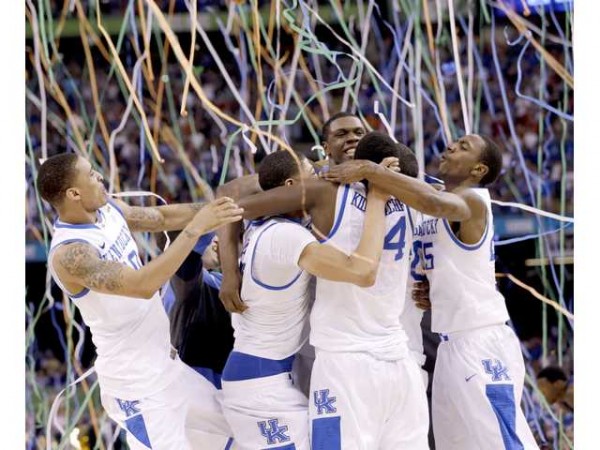Progress of Alex Poythress is Key to Kentucky’s Success
Posted by Brian Joyce on October 23rd, 2013Kentucky’s freshmen receive all the accolades. Kentucky was declared the number one team in the land by the coaches. NBA scouts may think James Young is the best player on Kentucky’s roster. Julius Randle may be the only bona fide NBA prospect and the best player in the SEC. The other freshmen, including the Harrison twins (Andrew Harrison and Aaron Harrison) and Dakari Johnson, may snatch up the other college basketball headlines. Yep, John Calipari’s latest freshman class is talented and deserves the publicity, but Kentucky needs to look to its not-so-distant past in order to mimic the program’s success with one-and-dones. When Kentucky achieved tremendous results (think Kansas, not Robert Morris), it wasn’t relying solely on first-year players.

For the Cats to return to glory, they will need contributions from more than just their freshmen. (AP)
A long, long time ago in a galaxy far, far away, a 6’9″ 18-year old freshman stepped into Rupp Arena and poured in 25 points in his first game in a Kentucky jersey. While Lexington certainly seems like a distant supernova in the basketball world, this moment in time wasn’t really all that long ago. It just seems like it was after a dismal 2012-13 season that resulted in a trip to the NIT. The freshman was Terrence Jones and the season was 2010-11. Jones went on to have a stellar first year in blue, dropping 29 points just two games later against Oklahoma, scoring 27 on Notre Dame, and in his second SEC game he put in 35, the most points ever scored by a freshman in Kentucky’s storied history. Jones was somewhat inconsistent that season, because after all he was a freshman; but the very next season, he was a key leader and “veteran” sophomore on a national championship team starting three freshmen.In his sophomore campaign, Jones improved his scoring and rebounding on the way to becoming a much more efficient player. He got to the rim a lot more often (48 percent of possessions in 2011-12 as compared to just 31 percent in 2010-11, according to Hoop-Math), and more importantly, he took better shots (decreasing his shot percentage from 27.2% in 2010-11 to a more manageable 22.6% in 2011-12, according to KenPom). Sure, he had some moments where one could question his progress, but in the end he became a key cog on a driven and determined machine. Though Kentucky’s freshman class was immensely talented, it would not have won six games in a row in March without the efforts and experience of Jones, Doron Lamb, and Darius Miller. With one of the best incoming classes in NCAA history entering the landscape this season, Kentucky looks to repeat its 2012 success. However, John Calipari also needs improvement from his top returnees, which brings us to sophomore forward Alex Poythress.
Poythress had some flashes of brilliance in his freshman campaign. He scored 20 points and snared eight rebounds in his second game against Duke, en route to four straight 20-point performances to start the season. At the time, Calipari even called the 6’7″ freshman a “beast.” But then came plenty of low moments. He failed to score in double figures in nine of the Cats’ 16 SEC games. Nor did he reach double figures in any the Wildcats’ SEC Tournament loss or the Cats’ lone NIT appearance. And of course, Kentucky failed to reach its lofty preseason expectations. If the Wildcats are to reach those championship levels of success and not suffer another disappointment, they will need to see progress from Poythress. We have critiqued his offensive game and found three areas where Poythress needs to improve in order to become the leader-by-example Calipari needs on this roster:
- More aggressiveness with the ball: Poythress had a solid offensive rating (110.9) and demonstrated he was capable of big games, but his possession percentage was an average 21.5 percent and his share of shots was just 19.5 percent despite leading the team in true shooting percentage and logging an impressive effective field goal percentage above 60 percent. Despite all the talent around him this season, he has to demand the ball more often and be more aggressive with it when he has it in his hands.
- Improve his mid-range game: Poythress got to the rim a lot (on 58 percent of his shots) and shot well from beyond the arc (42.4%), but his mid-range game struggled. As a freshman, he took 27 percent of his shots from this area, but he made just 23 percent of those attempts. That won’t draw much respect from defenders backing off his 12-footers to prevent another one of the “beast’s” monster dunks.
- Cut down on turnovers: Finally, Poythress needs to cut down on his mistakes with the basketball. Archie Goodwin was seen as out of control and wild by most of the Big Blue Nation last year, but it was Poythress who had the higher turnover percentage at 21.6 percent. He needs to make the most of his limited possessions, and giving the ball away twice per game is way too many.
Calipari could easily start at least three freshmen again this year, but for Kentucky to be as successful as it was in 2012, it needs Poythress and fellow sophomore returnee Willie Cauley-Stein to fill the experience and leadership roles that the Cats sorely lacked last season. The freshmen will perform well, but only with great contributions from the sophomores will Kentucky have a favorite’s shot to cut down the nets in Arlington.












































